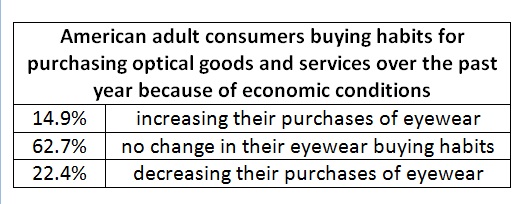 Many consumers are still hedging before purchasing optical goods and services, according to The Vision Council VisionWatch Economic Situation Study: May 2014. Only 14.9 percent of consumers have been increasing their purchases of eyewear over the past year as a result of economic changes, and 22.4 percent of American adult consumers are decreasing their purchases of eyewear as a result of economic conditions in the US. Just over three-fifths of all consumers say there has been no change in their eyewear buying habits over the past year because of economic conditions.
Many consumers are still hedging before purchasing optical goods and services, according to The Vision Council VisionWatch Economic Situation Study: May 2014. Only 14.9 percent of consumers have been increasing their purchases of eyewear over the past year as a result of economic changes, and 22.4 percent of American adult consumers are decreasing their purchases of eyewear as a result of economic conditions in the US. Just over three-fifths of all consumers say there has been no change in their eyewear buying habits over the past year because of economic conditions.
Somewhere between one-in-four to one-in-five patients in the practice are actively thinking about decreasing their purchases of optical goods and services. In practical terms that means one of four patients coming into the practice today has already made the decision to spend less money than at their last visit. Even though they need the care, and even though the quality of their life would be better, they are going to decrease their purchases of optical goods and services unless we intervene intelligently.

If we drill down to the demographic level so we can target our efforts, it is women and people over the age of 45 who are influenced most by the current economy and it so happens that these two demographic groups drive the US eyewear industry. We need to not only be aware of this, but to have systems in place to help patients get the care they need–especially patients in these two demographics.
Ed Rigsbee has an interesting article discussing emotional obstacles to purchasing. I’ve modified his major points to relate to the eyecare practice.
Most people buy emotionally and then look for the logic to justify their purchase decision. To say this another way, most people buy benefits, not features. Benefits are the emotional side and features are the logical side. But before you can get that far with a patient, every patient entering your practice must make three emotional decisions before they purchase. Here are those decisions.
Does your practice have the right product mix and quality to make my life better?
Here’s a helpful paradigm shift for you and your staff. View your product mix as your patients’ property that you are just holding. From this perspective, now look at your product mix for:
• Quality
• Price
• Selection
• Merchandising and Display
• Supporting marketing materials
Do I like doing business with your practice?
From this perspective look at your practice in the following areas:
• Your office policies
• Your local reputation
• The flow of your practice
• The feel of your practice
• How easy is it to find what is needed in your practice
• The outside appearance of your office
Do I like the people of your practice?
The number one reason patients do not return to your practice is staff. Likewise, the importance of staff in helping patients purchase is essential to recognize and address. Don’t forget how powerful it is for the doctor to prescribe in the exam room instead of just leaving it up to the optician. Here are questions to identify those staff and doctors who need help to improve.
• Is each staff member and doctor passionate about selling (i.e. helping patients get the care they need and deserve)?
• Is each staff member and doctor passionate in serving patients?
• Has each staff member and doctor identified what they want while employed and communicated that to the owners of the practice?
• Does the practice have a workable improvement plan for staff and doctors?
• Do staff and doctors build relationships with each other and with patients creating synergy?
• Do staff and doctors have an emotional commitment to each other and patients?
This article can be used in multiple staff meetings (e.g.: one staff meeting for each of the three emotional questions given above) as the basis for identifying issues that need to be addressed. Once the issues are identified, then prioritize them and implement system solutions for improvement.
Your action plan for this week is to make sure you have implemented systems in your practice for handling the issues raised in this article. As you implement these systems, keep in mind your targeted demographics are women and people over age 45.



























